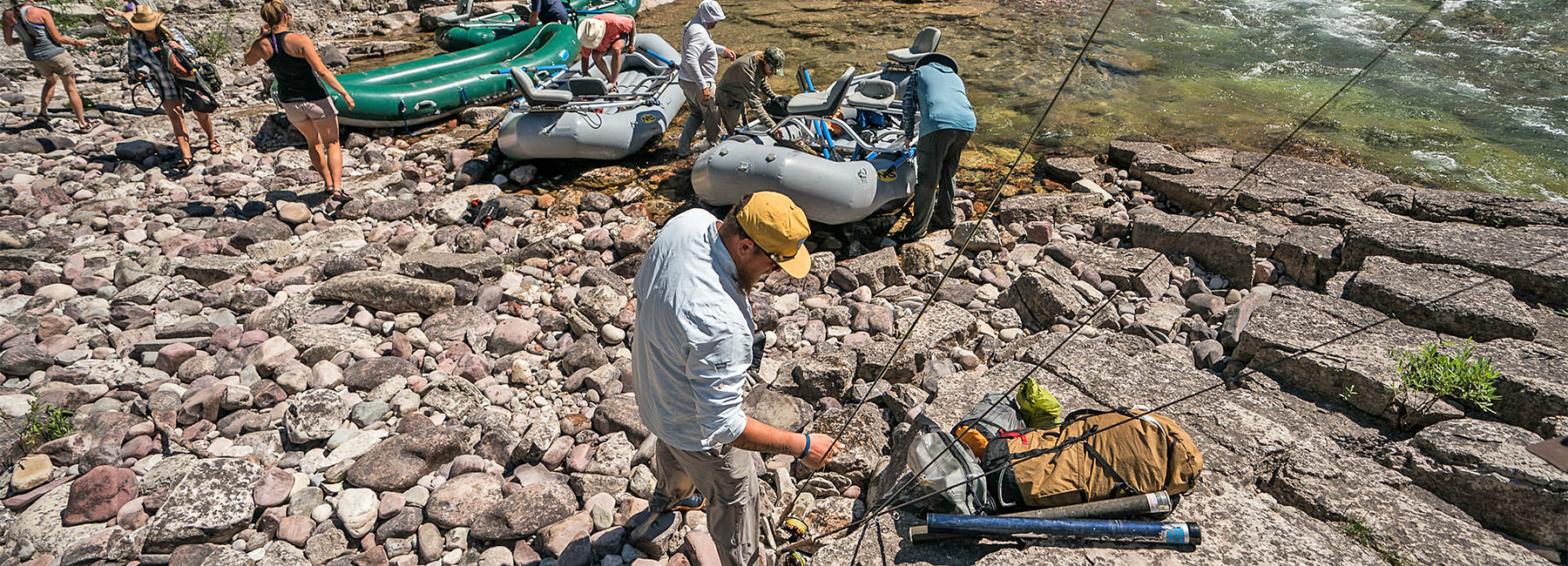Recommended Clothing and Equipment
Clothing:
The weather in the Rocky Mountain West is constantly changing. One afternoon it may be 90° (+) and sunny, down right hot; then only a few hours later it may be windy and hailing. July and August are more stable month and typically high pressure, sunny and hot. You are typically wearing lightweight, sun protective clothing that covers your skin. Early and late season brings more unpredictable and cooler weather, so you should always plan for any possible weather. Clothing strategies should be based on the “layering system.” By using the “layering system,” anglers can adapt to whatever Mother Nature dishes out. The whole idea behind layering is to trap heated air (generated by your body and stored between the different layers of insulation), thus keeping you warm.
Here is the formula preferred by the staff at The Fly Shop®:
1… Base Layer: Start off with a synthetic type fabric next to your skin. This often is a pair of thermal underwear (tops and bottoms) and they usually come in three weights: light, mid and expedition. According to your individual metabolism, pick what is best for you. Synthetic (non-cotton) materials retain little moisture and “wick” moisture away from your skin. This is very important when you are walking in waders or when outside temperatures heat up.
2… Thermal Layer: Your second layer of insulation should match the weather and conditions you are going to be fishing in. Lightweight insulation for cool weather, mid-weight for colder conditions and heavy weight for really frigid days. Fleece is an outstanding choice here in either tops and bottoms or overalls. Merino Wool is also a good choice as it stays warm when damp, though dries very slowly.
3… Outer Shell (Rain jacket & Waders): Your final layer should be a breathable rain jacket and waders.
- 1 set mid weight — Patagonia, Simms, and others (tops and bottoms)
- 1 set heavier pants and top — Patagonia, Simms, and others (tops and bottoms)
- 1 layering jacket — A lighter weight jacket that can fit under your wading jacket or that can be used by itself
Rain Jacket:
High quality Gore-Tex® type products are the best. Your rain jacket should be 100% waterproof and breathable. Rain jackets must be seam sealed, multi-layered, of QUALITY construction and from a recognized outdoor clothing company.Jackets specifically designed for fly fishermen are the best.
Wading Equipment:
Stocking foot, breathable waders are the only way to go. Neoprene waders are antiquated, do not permit moisture to escape, are heavy and cumbersome and only appropriate for sedentary fishing (float tubing) where insulation is the only concern. Gore-Tex® “Breathable” waders have totally revolutionized wading equipment. You will experience little or no moisture build-up inside the waders, even after a long hike; they wear like iron, and are comfortable to be in all day. Lastly, Gore-Tex® “Breathable” waders take up a fraction of the space neoprene waders take-up when packed in your duffel bag. All waders should be worn with synthetic fiber under-wader wear for maximum comfort, minimum moisture retention, and warmth. For safety we strongly recommend wearing a wading belt at all times.
On the hot summer days of July and August wet wading can be a great choice. This does not mean leave your waders at home, but a pair of wading socks and quick dry shorts is all the extra things you need and you will have the option to wet wade.
Socks:
Anglers should bring enough socks to alternate on a daily basis. For a week’s fishing trip, three pairs should be fine. Do not wear the same socks every day, but alternate, leaving one pair to dry and air while wearing the other set. Wool, polypro or a combination of both are the best choices in sock material. Try on your socks with your waders and wading boots before you leave for your trip to ensure that you have plenty of room to move your toes. Being unable to move your toes and cramping of your feet in your wading boots are the biggest reasons for numb toes and cold feet. We’ve experienced great success with the disposable air-activated heating pads available at many outdoor stores. Removal from the cellophane wrapper activates them and they then simply stick to the outside of socks for hours of cozy warmth.
- 2 – 3 pair of wool Wading Socks.
Wading Boots:
Felt soled wading boots are highly recommended as they offer superior ankle support and are exceptional for hiking to and from waters. Felt is still allowed in Colorado, Idaho and Montana and Washington, but keep in mind it is illegal to use felt boots in National Parks. Simms, Patagonia and Korkers make some good models to consider. Korkers are nice because you can change out felt soles for rubber, or studs depending on each situation. For the most part the rivers fished out west do not pose any real difficult wading situations, however the mostly gravel bottoms do get covered in algae (slime) and can be slippery. In these situations, studded boots can be handy. Gravel guards are a must. Make sure if you are bringing felt wading boots, they are clean and dry to prevent the spread of invasive species. If you are fishing during summer months, consider brings some wading sandals or some kind of outdoor sandal like Tevas or Chacos.
Wool or Polypropylene Gloves:
For Early and late season, fingerless gloves are great for cold and or rainy days. Neoprene gloves are fine, but retain a lot of water when wet. We have had the best success with synthetic or wool gloves.
Fishing Vest or Tackle Pack:
For vests, we like a high quality product, in a ‘shorty’ model. Choose one that has room for a rain jacket, or camera in the back. Brands we like are Simms and Umpqua. If you prefer a tackle pack, take a good look at Fish Pond, Patagonia or Simms.
Small Day Pack:
This can be an important article to include while packing. We like a waterproof, top-loader day pack that can hold extra gear, clothes, flies, camera, snacks, etc.
Boat Bag:
A waterproof boat “dry bag” can be extremely handy for storing extra clothes, tackle and camera equipment while on a boat or raft. The white water type “dry bags” are the best.
Fishing Hat:
July and August in the West can be clear and bright with lots of sun. A good hat to keep the glare off your eyes and the sun off your face is imperative. Look for a hat that is comfortable, relatively waterproof, and that has a good size brim.
Line clippers, Pliers, Hemostats, & Hook File:
These are essential to any fisherman and should not be left behind.
Polarized Sunglasses:
Fly fishing is often a very visual experience. Spotting the fish is part of the excitement, and part of the challenge. Good quality polarized sunglasses are a must. Polarized sunglasses not only let you spot fish more effectively, but protect your eyes from the intense sunlight experienced in Idaho, as well as hooks. Costa and Smith make some of the best in the industry.
Camera:
Waterproof digital or splash-proof digital cameras are handy. If you are going to take your digital SLR camera, make sure you have a waterproof case for it. The best waterproof cases we have found to protect expensive camera equipment are made by Pelican Products, www.pelican.com. Don’t forget your flash unit.
Headlamp:
Our favorite is the Loon Nocturnal Headlamp, preferring models with an LED bulb(s).
Sun Protection:
The summer weather in the Rocky Mountains is generally pleasant with average temperatures ranging between the low 60’s and mid 90’s. Wide-brimmed hats, long-sleeved shirts, and frequent use of sun block (SPF 30+ UVA/UVB) are highly recommended. Sun gloves will save the backs of your hands and a Buff to cover your face and neck.
Bug Repellent:
Although bugs are usually not too big a problem in the Rockies especially mid-summer. But there are spots with some biting insects and mosquitos and a bottle of bug dope with active ingredient DEET is not a bad idea to include in your tackle bag.
Camp Shoes:
After a long day of fishing, it’s nice to get out of your waders and slip into a comfortable pair of shoes to wear around the lodge. Crocs are a great choice and super lightweight.
Wading Staff:
If you use a wading staff on your home waters, then bring it, it will come in handy.

